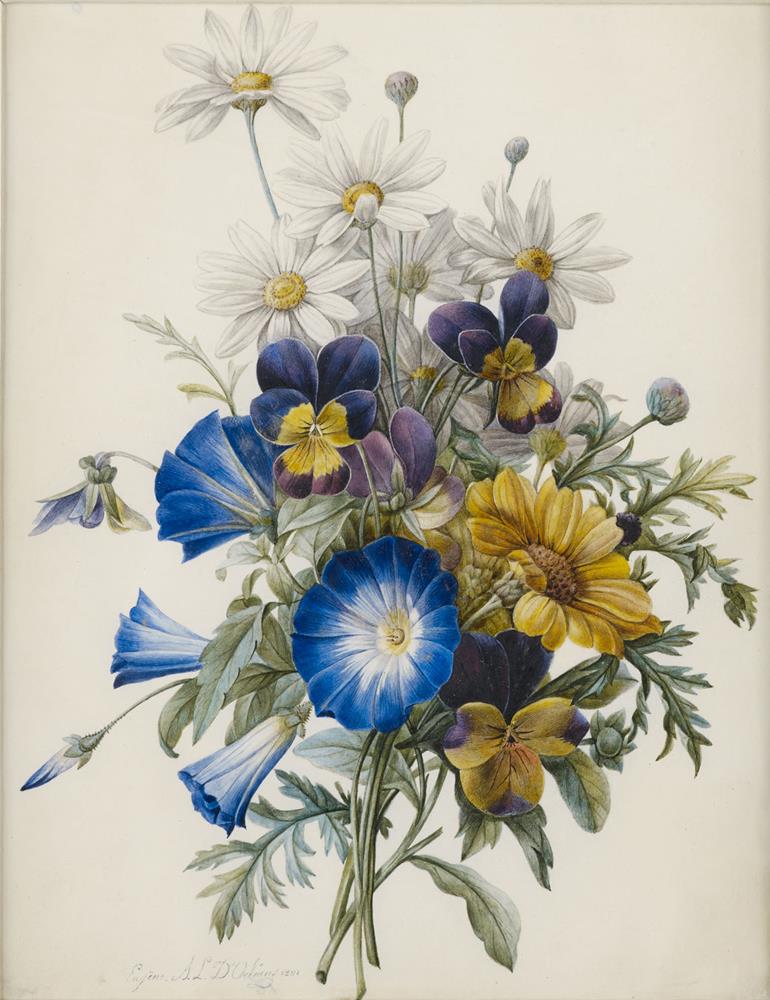Princesse Louise Marie Eugénie Adélaïde d’Orléans ( 1777 - 1847 )
Pansies, Morning Glories and Single Chrysanthemums

Pansies, Morning Glories and Single Chrysanthemums
watercolour, body colour and graphite on vellum,
signed and dated 1821, with fine period frame.
Sold, summer 2015
item sold
Princesse Adélaïde was the sister of Louis Philippe, King of France from 1830 to 1848. This exquisite watercolour on vellum demonstrates why she was not only one of Pierre-Joseph Redouté’s most famous pupils, but arguably his most talented.
Adélaïde’s early years were rocked by the political upheavals that engulfed France from the late eighteenth century onwards. As the situation in the 1790’s in the capital deteriorated, Adélaïde was forced to flee France and would not return home for over twenty years until the fall of Napoleon in 1814. Her father was guillotined during the Terror of 1792 and her mother banished to Spain, destroying any hope of a homecoming. Her faithful governess, Madame de Genlis, accompanied her at all times during her exile which took her from the Austrian-occupied Netherlands to Switzerland, Bratislava and Barcelona, before finally settling in 1809 with Louis Philippe in Palermo.
On her return to Paris in 1814 Adélaïde took up residence with her extended family in the Palais-Royal, where she devoted her intellectual powers and political ambitions to helping her brother. For an unmarried woman she had an unusually prominent participation in the family councils of the house of Orléans, acting as Louis Philippe’s confidante and adviser. In Adélaïde’s appartment at the Palais she would host a Salon which soon became a centre for the opposition towards the Bourbon regime where artists and intellectuals rubbed shoulders with a liberal press and influential figures including Talleyrand. Through this enlightened environment, Adélaïde sought to create a constitutional monarchy headed by her brother. This dream came to fruition in 1830 with the July Revolution.
Given such a role in the history and politics of her time, it is remarkable that this ambitious and intelligent woman became one of the most accomplished students of her great flower painting master, Redouté. Judging from its date, 1821, Redouté would have instructed her privately at her apartment in the Palais. Using a calf skin vellum as a medium required discipline and a virtuoso technique: matchlessly smooth washes of watercolour built up over a delicate pencil under-drawing which forbade any retouches or errors. The Fitzwilliam Museum in Cambridge owns a vellum by Adélaïde, dated 1820 which is a free copy of a Redouté in the same museum and yet our Pansies, Morning Glories and Single Chrysanthemums, from the following year, is an original composition.
This fine and unblemished watercolour is close in quality to those of Adelaide’s master, Redouté, of the same period, and yet it is all the more intriguing that this remarkable woman could paint as well in this exacting technique without there remaining today more than a handful of her creations.

